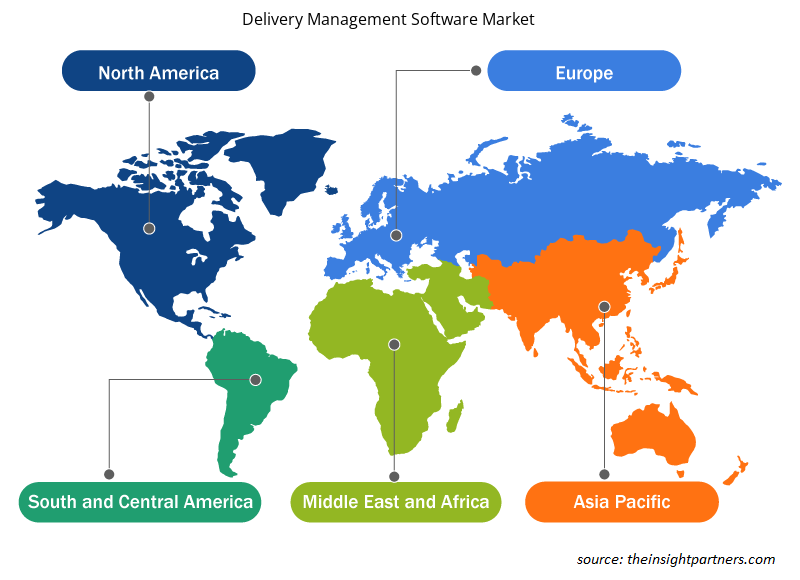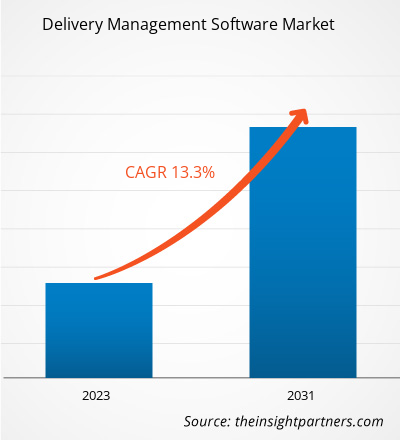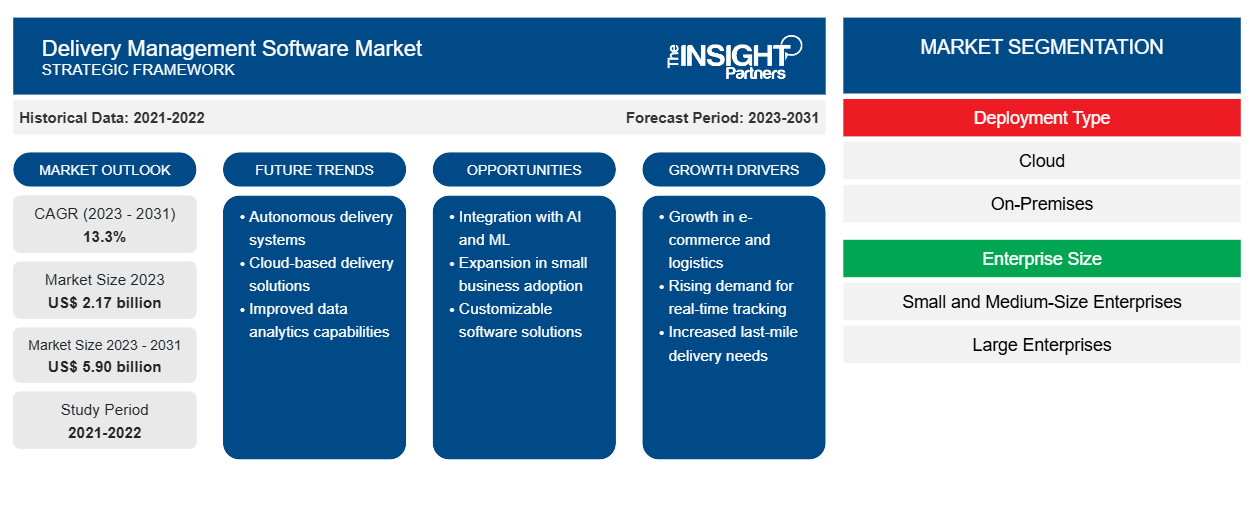La taille du marché des logiciels de gestion de livraison devrait atteindre 5,90 milliards de dollars américains d'ici 2031, contre 2,17 milliards de dollars américains en 2023. Le marché devrait enregistrer un TCAC de 13,3 % de 2023 à 2031.
L’intégration des technologies d’IA et de ML dans les logiciels de gestion des livraisons pour améliorer l’expérience client devrait rester une tendance clé du marché des logiciels de gestion des livraisons.
Analyse du marché des logiciels de gestion des livraisons
Le marché des logiciels de gestion des livraisons connaît une croissance rapide en raison de l'expansion du secteur du commerce électronique et de la demande croissante d'informations en temps réel pour la gestion de la logistique et des chaînes d'approvisionnement. Le marché est en constante expansion, porté par la croissance démographique, la numérisation croissante et la préférence des consommateurs pour les achats en ligne. De plus, la demande croissante d'automatisation par les utilisateurs finaux offre des opportunités lucratives de croissance du marché.
Aperçu du marché des logiciels de gestion des livraisons
Les logiciels de gestion des livraisons permettent de suivre les expéditions et d'assurer la livraison ponctuelle des articles aux clients. L'utilisation de logiciels de gestion des livraisons innovants offre des avantages considérables aux entreprises, notamment l'augmentation de l'utilisation des actifs, l'amélioration de la satisfaction des clients et la réduction de la consommation de carburant. Le logiciel relie le livreur et les bureaux administratifs sur une seule plateforme et fournit les informations dont un chauffeur a besoin pour livrer un article. La demande croissante d'informations en temps réel et d'un meilleur suivi des livraisons stimule le marché.
Personnalisez ce rapport en fonction de vos besoins
Vous bénéficierez d'une personnalisation gratuite de n'importe quel rapport, y compris de certaines parties de ce rapport, d'une analyse au niveau des pays, d'un pack de données Excel, ainsi que de superbes offres et réductions pour les start-ups et les universités.
-
Obtenez les principales tendances clés du marché de ce rapport.Cet échantillon GRATUIT comprendra une analyse de données, allant des tendances du marché aux estimations et prévisions.
Moteurs et opportunités du marché des logiciels de gestion des livraisons
L'expansion du secteur du commerce électronique stimule le marché
L'expansion du secteur du commerce électronique et la demande croissante de services de livraison au dernier kilomètre parmi les consommateurs alimentent le marché. Le commerce électronique se développe rapidement dans le monde entier, car de plus en plus de consommateurs préfèrent les achats en ligne comme option pratique. Cela se traduit par une forte demande de services de livraison parmi les consommateurs, en particulier la livraison au dernier kilomètre. La livraison au dernier kilomètre est un élément crucial du commerce électronique. Elle implique le transport des marchandises de l'entrepôt jusqu'au domicile du client. Les entreprises de commerce électronique s'efforcent de garantir que leurs articles parviennent aux clients rapidement et à moindre coût, ce qui augmente la demande de logiciels de gestion des livraisons parmi les entreprises. Cependant, l'expansion du secteur du commerce électronique et l'évolution de la préférence des consommateurs pour les achats en ligne alimentent le marché.
La demande croissante d’automatisation de la part des utilisateurs finaux – Une opportunité sur le marché des logiciels de gestion des livraisons
L’émergence de technologies de pointe présente un potentiel de croissance rentable pour le marché des logiciels de gestion des livraisons. Les grands acteurs du marché des logiciels de gestion des livraisons réalisent des investissements importants dans l’adoption des technologies d’IA et de ML pour automatiser leurs processus de livraison. De plus, l’automatisation gagne du terrain dans la gestion des livraisons en aidant les entreprises à améliorer leurs procédures d’exécution des commandes et de livraison. L’automatisation aide les utilisateurs finaux, tels que les livreurs de restaurants, les logisticiens, les coursiers et autres, à rationaliser les procédures, à réduire les coûts et à améliorer l’expérience client. De nombreuses technologies d’automatisation telles que l’optimisation des itinéraires, les portails en libre-service et la livraison automatisée sont largement adoptées par les entreprises de logistique pour une livraison de produits plus rapide et plus efficace.
Analyse de segmentation du rapport sur le marché des logiciels de gestion des livraisons
Les segments clés qui ont contribué à l’élaboration de l’analyse du marché des logiciels de gestion de livraison sont le type de déploiement, la taille de l’entreprise et l’utilisateur final.
- En fonction du type de déploiement, le marché des logiciels de gestion des livraisons est divisé en cloud et sur site. Le segment cloud détenait une part de marché plus importante en 2023.
- En termes de taille d'entreprise, le marché des logiciels de gestion des livraisons est divisé en petites et moyennes entreprises et en grandes entreprises. Le segment des grandes entreprises détenait une part de marché plus importante en 2023.
- En fonction de l'utilisateur final, le marché est segmenté en livraison de restaurants, logistique, messagerie et autres. Le segment de la logistique détenait la plus grande part du marché en 2023.
Analyse des parts de marché des logiciels de gestion des livraisons par zone géographique
La portée géographique du rapport sur le marché des logiciels de gestion de livraison est principalement divisée en cinq régions : Amérique du Nord, Asie-Pacifique, Europe, Moyen-Orient et Afrique, et Amérique du Sud/Amérique du Sud et centrale.
En termes de chiffre d'affaires, l'Asie-Pacifique représente la plus grande part de marché des logiciels de gestion des livraisons, grâce à l'expansion du secteur du commerce électronique, à la croissance de la population et à la préférence des consommateurs pour les achats en ligne. La demande croissante de logiciels de gestion des livraisons parmi les entreprises pour rationaliser leurs processus de livraison en réduisant les coûts logistiques supplémentaires stimule le marché. De plus, les progrès technologiques et la demande croissante de logiciels basés sur le cloud pour gérer de manière appropriée la livraison des produits créent des opportunités sur le marché.
Actualités et développements récents du marché des logiciels de gestion des livraisons
Le marché des logiciels de gestion des livraisons est évalué en collectant des données qualitatives et quantitatives après des recherches primaires et secondaires, qui incluent d'importantes publications d'entreprise, des données d'association et des bases de données. Voici une liste des évolutions du marché des logiciels et des stratégies de gestion des livraisons :
- En février 2024, Inspire Brands a acheté « Vromo » pour rationaliser les canaux de livraison. Vromo est un logiciel de livraison de nourriture en ligne qui aide Inspire Brands à gérer son processus de livraison en offrant des avantages de suivi de livraison au client final. (Source : Inspire Brands, communiqué de presse, 2024)
Aperçu régional du marché des logiciels de gestion des livraisons
Les tendances et facteurs régionaux influençant le marché des logiciels de gestion des livraisons tout au long de la période de prévision ont été expliqués en détail par les analystes d’Insight Partners. Cette section traite également des segments et de la géographie du marché des logiciels de gestion des livraisons en Amérique du Nord, en Europe, en Asie-Pacifique, au Moyen-Orient et en Afrique, ainsi qu’en Amérique du Sud et en Amérique centrale.

- Obtenez les données régionales spécifiques au marché des logiciels de gestion des livraisons
Portée du rapport sur le marché des logiciels de gestion des livraisons
| Attribut de rapport | Détails |
|---|---|
| Taille du marché en 2023 | 2,17 milliards de dollars américains |
| Taille du marché d'ici 2031 | 5,90 milliards de dollars américains |
| Taux de croissance annuel composé mondial (2023-2031) | 13,3% |
| Données historiques | 2021-2022 |
| Période de prévision | 2023-2031 |
| Segments couverts |
Par type de déploiement
|
| Régions et pays couverts |
Amérique du Nord
|
| Leaders du marché et profils d'entreprises clés |
|
Densité des acteurs du marché des logiciels de gestion des livraisons : comprendre son impact sur la dynamique des entreprises
Le marché des logiciels de gestion des livraisons connaît une croissance rapide, tirée par la demande croissante des utilisateurs finaux en raison de facteurs tels que l'évolution des préférences des consommateurs, les avancées technologiques et une plus grande sensibilisation aux avantages du produit. À mesure que la demande augmente, les entreprises élargissent leurs offres, innovent pour répondre aux besoins des consommateurs et capitalisent sur les tendances émergentes, ce qui alimente davantage la croissance du marché.
La densité des acteurs du marché fait référence à la répartition des entreprises ou des sociétés opérant sur un marché ou un secteur particulier. Elle indique le nombre de concurrents (acteurs du marché) présents sur un marché donné par rapport à sa taille ou à sa valeur marchande totale.
Les principales entreprises opérant sur le marché des logiciels de gestion des livraisons sont :
- Deliforce Technologies Private Limited
- FarEye (RoboticWares Pvt Ltd)
- GetSwift Limitée
- Travaux de la jungle
- Loginext Solutions Private Limited
- Mobisoft Infotech LLC
Avis de non-responsabilité : les sociétés répertoriées ci-dessus ne sont pas classées dans un ordre particulier.

- Obtenez un aperçu des principaux acteurs du marché des logiciels de gestion des livraisons
Rapport sur le marché des logiciels de gestion des livraisons et livrables
Le rapport « Taille et prévisions du marché des logiciels de gestion des livraisons (2023-2031) » fournit une analyse détaillée du marché couvrant les domaines ci-dessous :
- Taille du marché et prévisions aux niveaux mondial, régional et national pour tous les segments de marché clés couverts par le périmètre
- Dynamique du marché, comme les facteurs moteurs, les contraintes et les opportunités clés
- Principales tendances futures
- Analyse détaillée des cinq forces de PEST/Porter et SWOT
- Analyse du marché mondial et régional couvrant les principales tendances du marché, les principaux acteurs, les réglementations et les développements récents du marché
- Analyse du paysage industriel et de la concurrence couvrant la concentration du marché, l'analyse de la carte thermique, les principaux acteurs et les développements récents
- Profils d'entreprise détaillés
- Analyse historique (2 ans), année de base, prévision (7 ans) avec TCAC
- Analyse PEST et SWOT
- Taille du marché Valeur / Volume - Mondial, Régional, Pays
- Industrie et paysage concurrentiel
- Ensemble de données Excel
Rapports récents
Rapports connexes
Témoignages
Raison d'acheter
- Prise de décision éclairée
- Compréhension de la dynamique du marché
- Analyse concurrentielle
- Connaissances clients
- Prévisions de marché
- Atténuation des risques
- Planification stratégique
- Justification des investissements
- Identification des marchés émergents
- Amélioration des stratégies marketing
- Amélioration de l'efficacité opérationnelle
- Alignement sur les tendances réglementaires























 Obtenez un échantillon gratuit pour - Marché des logiciels de gestion des livraisons
Obtenez un échantillon gratuit pour - Marché des logiciels de gestion des livraisons